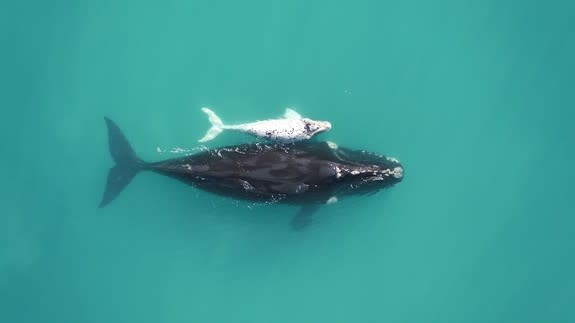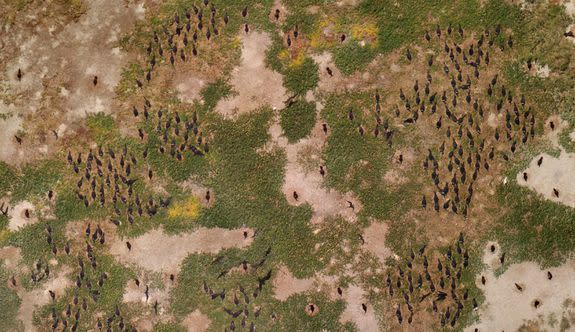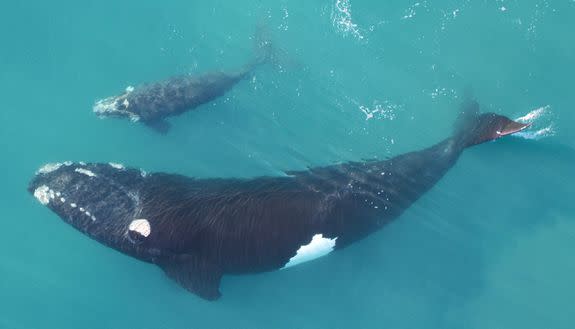Why drones are a game-changer for animal research

Over the Southern Ocean and remote Australian grasslands, there are flying robots — drones, actually, but they're not for purposes of counterterrorism or Amazon deliveries. Rather, these unmanned aerial vehicles are being used by research scientists to sidestep time-consuming, labor-intensive work that was once done by foot, boat, or via expensive plane flights: tracking animal behavior.
SEE ALSO: This robot may have just ruined your sick day
While humans have always been curious to learn about the habits of animals, such research is more pressing than ever. Habitat loss and climate change are having dramatic impact on almost all species — estimates suggest as many as 1 in 6 species may go extinct due to global warming. The need to know more is urgent, and drones are changing the game by allowing scientists to be more ambitious and efficient with their studies.
Chris Johnson, an ocean sciences manager at WWF Australia in Melbourne, is involved in whale research in the Great Australian Bight. In the past, he said, a study to, say, observe the size of breeding whales would require flying an airplane at low altitude, and even briefly sticking one's head and camera outside the aircraft at high speed to capture images as detailed as those done by drone during the Bight project.
"Drones actually make it safer for researchers to do very similar work," he said, particularly getting close enough to recognize individual whales. It also costs less: The drone they used in 2016 was an off-the-shelf DJI Inspire 1 Pro, priced at around A$5,600 (US$4,289) total, along with some additional lens, hard drive and battery costs. The team's Bight drone project lasted three months, whereas he estimated that a plane doing the same job might cost roughly between A$3,000 (US$2,298) to A$10,000 (US$7,659) per day.
"It's a win-win tool — it's really changing, really disrupting, whale research — they're seeing behaviors that are very difficult to document by airplane," he added.

Image: Jarrod Hodgson
For Debra Saunders, an ecologist at the Australian National University in Canberra, drones have also cut down on labor.
While looking at the habits of a critically endangered migratory bird, the swift parrot, she hit up against the shortcomings of traditional techniques. Because it's such a small creature, typical satellite or GPS tags were too cumbersome to attach to the tiny critters, and "by foot" counting methods were too slow.
So Saunders helped develop a drone to do the same work from the air. It can track small transmitters attached to the animal, weighing only about one gram, that send a radio signal back to base camp.
When launched, the drone does a one-minute rotation on the spot looking for the signal of tagged animals in the area and giving Saunders and her team their approximate location. Based on that information, it automatically decides where the next best place is to maximize data collection about the bird's whereabouts.
"With two or three rotations, you can pinpoint where an animal is within 10 meters (33 feet)," she said. "That's like an hour's worth of work in less than 10 minutes."
An imperfect improvement
While drones have already significantly sped up animal research, they still have one glaring problem: battery life.
That's an issue for Johnson, whose work often occurs out at sea. "Some whale research I do that's off the continental shelf of Southwest Australia — that's 25 miles (40 kilometers) away, so you need a different type of drone, which is very expensive," he said.
Meanwhile, in the south of Australia at the Unmanned Research Aircraft Facility (URAF) in Adelaide, Jarrod Hodgson and his team are using drones to monitor wildlife from koalas to marine mammals.
Hodgson also cited aircraft battery endurance as a factor that would help increase the machines' impact on animal studies, as well as better sensors. "The continued integration of sensors to allow drones to make decisions and fly autonomously, avoiding moving obstacles for example, will also create new possibilities," he said via email.

Image: WWF Australia
Ethical questions
At URAF, Hodgson is investigating whether animals are disturbed by unmanned aircraft. After all, there's there's little point in using drones to better understand wild animals if those same aircraft affect the animals' behavior.
So in 2016, he helped write an animal-drone code of conduct. "Currently, we have a limited understanding of the potential impacts that drones may have on wildlife," he said. "We expect that wildlife responses will vary due to factors such as an animal's life history, its ability to detect the drone and also its environment."
Like Hodgson, Saunders noted the aim of any wildlife researcher should be to understand the animal's natural behavior, not its disturbed behavior. If researchers can ensure drones aren't causing a ruckus, the technology could even improve on by-foot research, which can be surprisingly disruptive.

Image: Fredrik Christiansen / Murdoch University Cetacean Research Unit
"Many small animals live in tall grasses, so by just physically going close to the animal [on foot], you're trampling the very habitat that they use and altering their behavior," she said. "This is one of the benefits of using [drones], in that we don't actually have to get close to the animal."
It seems clear that researchers will need to abide by high standards for drones to have impact that improves on traditional methods. While most animal studies require research permits, Johnson also suggested it was also important researchers have proper drone-piloting credentials.
"I think that we do have to be cautious, especially around wildlife," he said. "There are already so many impacts on them, from loss of habitat to climate change no matter what species, so it's important that researchers using drones have proper permits, proper training."
As humans grapple with their role in climate change, it may seem strange that little robotic collections of metal and plastic could make a difference. In the hands of scientists however, they could become powerful tools for understanding animal populations in crisis.
